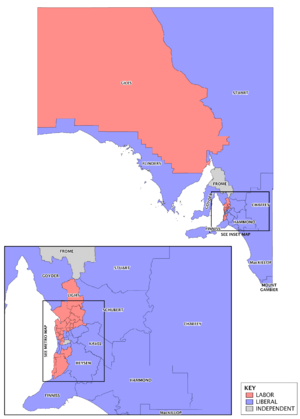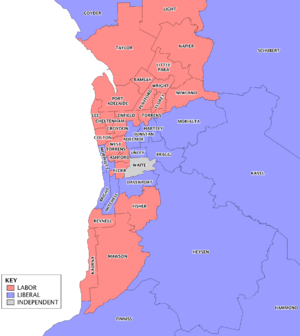Regions of South Australia facts for kids
In South Australia, one of the states of Australia, there are many areas which are commonly known by regional names. Regions are areas that share similar characteristics. These characteristics may be natural such as the Murray River, the coastline, desert or mountains. Alternatively, the characteristics may be cultural, such as common land use. South Australia is divided by numerous sets of regional boundaries, based on different characteristics. In many cases boundaries defined by different agencies are coterminous.
Contents
Informal divisions
Convention and common use has divided South Australia into a number of regions. These do not always have strict boundaries between them and have no general administrative function or status. Many of them correspond to regions used by various administrative or government agencies, but they do not always have the same boundaries or aggregate in the same way. The generally accepted regions are:
- Adelaide Plains (the northern part is sometimes known as the Lower North)
- Adelaide Hills/Mount Lofty Ranges
- Barossa Valley
- Eyre Peninsula
- Far North
- Fleurieu Peninsula
- Flinders Ranges
- Kangaroo Island
- Limestone Coast is a name which came into use in the early 21st century, supplanting the names Lower South East and Upper South East
- Mid North
- Murray Mallee
- Murraylands
- Riverland
- Yorke Peninsula
Most of the other regional divisions of the state use a combination of these same labels, sometimes grouped, and sometimes with precise boundaries that might be slightly different in each case.
South Australian Government
South Australian Government regions
South Australian government departments and agencies with some exceptions use a uniform set of boundaries to describe the extent of 12 administrative regions within the state which are used to “develop and improve reporting, planning and service delivery systems”.
Adelaide metropolitan area
- Eastern Adelaide
- Northern Adelaide
- Southern Adelaide
- Western Adelaide
Greater Adelaide area
- Adelaide Hills
- Barossa Light and Lower North
- Fleurieu Kangaroo Island
Country regions
- Eyre Western
- Far North
- Limestone Coast
- Murray Mallee
- Yorke Mid North
Department of Environment, Water and Natural Resources
Protected areas
South Australia's protected areas are grouped into 11 regions:
- Adelaide
- Adelaide Hills
- Barossa
- Clare Valley
- Eyre Peninsula
- Fleurieu Peninsula
- Flinders Ranges and Outback
- Kangaroo Island
- Limestone Coast
- Murray River
- Yorke Peninsula
Natural resource management
The Natural Resources Management Act 2004 established the following Natural Resources Management (NRM) regions “to give ownership of and responsibility for NRM to regional communities”: Adelaide and Mount Lofty Ranges, Alinytjara Wilurara, Eyre Peninsula, Kangaroo Island, Northern and Yorke, South Australian Arid Lands, South Australian Murray-Darling Basin and the South East.
Department of Primary Industries & Regions
The Department of Primary Industries & Regions (PIRSA) supports economic development in the non-metropolitan regions of South Australia. It identifies seven non-metropolitan regions:
- Adelaide Hills Fleurieu and Kangaroo Island
- Barossa
- Far North
- Limestone Coast
- Murraylands and Riverland
- Whyalla and Eyre Peninsula
- Yorke and Mid North
Electoral districts
South Australia is divided into 47 electoral districts each of which elects a single member into the South Australian House of Assembly (also called the lower house of parliament).
It is divided into eleven electoral divisions which each elect a member into the House of Representatives of the Parliament of Australia. These divisions are:
The federal divisions overlay the state electoral districts, but do not aggregate them. A state district may be divided amongst two or more federal divisions.
Biogeographic regions
The Interim Biogeographic Regionalisation for Australia (IBRA) is a biogeographic regionalisation of Australia; divided into 89 bioregions and 419 subregions. Each region is a land area made up of a group of interacting ecosystems that are repeated in similar form across the landscape. Regions and subregion cross state and territory boundaries. The bioregions that are located wholly or partly in South Australia are:
- Broken Hill Complex (shared with New South Wales)
- Central Ranges (shared with Western Australia and Northern Territory)
- Channel Country (mostly in Queensland but also South Australia, New South Wales and Northern Territory)
- Eyre Yorke Block
- Finke (shared with Northern Territory)
- Flinders Lofty Block (mostly in South Australia but extends to New South Wales)
- Furneaux (shared with Victoria)
- Great Victoria Desert (shared with Western Australia)
- Gawler
- Kanmantoo
- Murray Darling Depression (shared with New South Wales and Victoria)
- Naracoorte Coastal Plain (shared with Victoria)
- Nullarbor (shared with Western Australia)
- Riverina (mostly in New South Wales and Victoria)
- Simpson Strzelecki Dunefields (shared with New South Wales, Northern Territory and Queensland)
Industry regions
Tourist regions
South Australia has been divided into the following 12 tourism regions for the purpose of coordinating both government and tourism industry efforts to promote South Australia as a visitor destination: Adelaide, Adelaide Hills, Barossa, Clare Valley, Eyre Peninsula, Fleurieu Peninsula, Flinders Ranges and Outback, Kangaroo Island, Limestone Coast, Murray River, Lakes & Coorong, Riverland and Yorke Peninsula.
Wine regions
The wine industry has a number of defined wine zones and regions, however they do not cover the entire state (especially as some areas are not suitable for growing grapes). These are controlled as Australian geographical indications by the Australian Grape and Wine Authority. As of March 2015, the following zones are in use in South Australia: Barossa, Far North, Fleurieu, Lower Murray, Limestone Coast, Mount Lofty Ranges and The Peninsulas.




